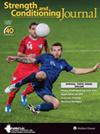The Effects of Training Interventions on Interlimb Asymmetries: A Systematic Review With Meta-analysis
IF 3
4区 医学
Q2 SPORT SCIENCES
引用次数: 8
Abstract
ABSTRACT Interlimb asymmetries have been recently investigated in athletic populations. However, the effects of training interventions on interlimb asymmetries have been scarcely examined. Therefore, the aim of this study was to determine the effects of training interventions on changes in interlimb asymmetries from pre- to post-training. Furthermore, to examine the effects of training programs on intervention groups compared with control groups. A database search was completed (MEDLINE, CINAHL, and SPORTDiscus). Eight studies were then included in the meta-analysis. Results showed small reductions in interlimb asymmetries in single-leg broad jump (SLBJ) and change of direction (COD) speed from pre- to post-training interventions, whereas moderate effects were found in single-leg countermovement jump (SLCMJ) and SL lateral jump. When comparing the training interventions with the control groups, results showed small effects in favor of the training groups for reducing interlimb asymmetries in SLBJ and large effects in SLCMJ and COD speed. Thus, training interventions can evoke small to moderate reductions in interlimb asymmetries from pre- to post-training programs. Strength training performed unilaterally or bilaterally may elicit these reductions. Furthermore, training interventions showed larger effects compared with the control groups in reducing interlimb asymmetries. However, further research is needed.训练干预对四肢不对称的影响:Meta分析的系统评价
摘要:最近对运动人群中的四肢间不对称现象进行了研究。然而,训练干预措施对智力间不对称的影响几乎没有得到研究。因此,本研究的目的是确定训练干预对训练前后四肢不对称变化的影响。此外,与对照组相比,检验训练项目对干预组的影响。数据库搜索已完成(MEDLINE、CINAHL和SPORTDiscus)。八项研究被纳入荟萃分析。结果显示,从训练前到训练后,单腿跳远(SLBJ)和方向改变(COD)速度的四肢不对称性略有减少,而单腿反动作跳(SLCMJ)和SL侧跳效果中等。当将训练干预措施与对照组进行比较时,结果显示,训练组在减少SLBJ的肢体间不对称方面效果较小,而在SLCMJ和COD速度方面效果较大。因此,从训练前到训练后,训练干预可以引起小到中等程度的林间不对称减少。单侧或双侧进行的力量训练可能会导致这些减少。此外,与对照组相比,训练干预在减少四肢间不对称方面显示出更大的效果。然而,还需要进一步的研究。
本文章由计算机程序翻译,如有差异,请以英文原文为准。
求助全文
约1分钟内获得全文
求助全文
来源期刊

Strength and Conditioning Journal
社会科学-运动科学
CiteScore
4.70
自引率
8.00%
发文量
49
审稿时长
6-12 weeks
期刊介绍:
Strength and Conditioning Journal is the professional journal for strength coaches, personal trainers, physical therapists, athletic trainers, and other health professionals working in the strength and conditioning field. The journal’s mission is to publish articles that report both the practical applications of research findings and the knowledge gained by experienced professionals.
 求助内容:
求助内容: 应助结果提醒方式:
应助结果提醒方式:


